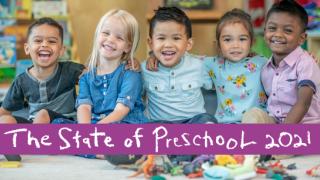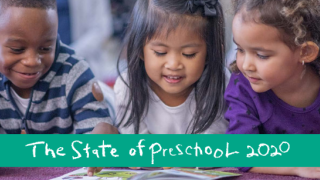
The State of Preschool Yearbook
The State of Preschool Yearbook tracks state-funded preschool efforts annually since 2001-2002, offering vital insights for informed early childhood education decisions.
The State of Preschool Yearbook has been a steadfast annual companion since the 2001-2002 school year, meticulously monitoring state-funded preschool program funding, access, and policies. This enduring commitment aims to illuminate state endeavors in extending high-quality education to our youngest learners. As an invaluable resource, the Yearbook equips policymakers, advocates, and researchers with crucial insights, enabling them to make well-informed decisions that shape the landscape of early childhood education. In a world where knowledge is power, this report empowers those dedicated to the betterment of our children's educational journey.
Recent Past Yearbooks
The 21st State of Preschool finds the state of preschool in America at a critical moment. The states have emerged, albeit unevenly, from the worst of the COVID-19 pandemic, and are poised to make new progress toward more effective and equitable preschool policies. Additional states have committed to offering every child publicly funded preschool education and have begun working towards that goal. Enrollment in preschool increased in 2022-2023 and the percent of 3-year-olds and 4-year-olds enrolled in preschool reached all-time highs. But the number of children enrolled in state-funded preschool is still lower than it was prior to the pandemic, and six states are still without programs.
The 20th State of Preschool finds reasons for both optimism and concern. After the COVID-19 pandemic erased a decade of enrollment progress in state-funded preschool, enrollment in most states is on the rebound. Several states are newly working towards universal preschool. Nevertheless, most states remain far from offering high-quality, full-day preschool to even half of 3- and 4-year-olds. This report finds uneven progress nationally and state-by-state over the past year, since the beginning of the COVID-19 pandemic, and over the past two decades.
Across the 44 states, DC, and Guam that funded a preschool program in 2020-2021, 29% of 4-year-olds and 5% of 3-year-olds were enrolled, a substantial decrease from pre-pandemic levels, erasing a decade of growth in preschool enrollment. Three state-funded preschool programs made changes to gain an additional benchmark for minimum quality standards (KS, UT, WA ECEAP). State funding for preschool fell by $254 million (adjusted for inflation) but spending from all sources increased. State preschool spending per child remains essentially the same as two decades ago, adjusting for inflation, below $6,000.
Across the 44 states, DC, and Guam that funded a preschool program in 2019-2020, 34% of 4-year-olds and 6% of 3-year-olds were enrolled, essentially the same as last year. Three state-funded preschool programs made changes to gain an additional benchmark for minimum quality standards. States spent $300 million more on preschool (adjusted for inflation) than the prior year and state spending per child increased after two years of stagnation. However, most states still spend too little per child to support high-quality, full-day pre-K and most do not come close to reaching all 3- and 4-year-olds or even all low-income 3- and 4-year-olds.





